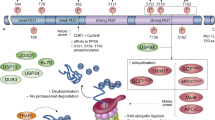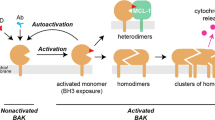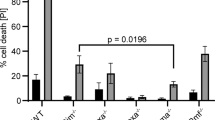Abstract
MEMBERSof the Bcl-2 family of proteins are characterized by their ability to modulate cell death. Bcl-2 and some of its homologues inhibit apoptosis1–4, whereas other family members, such as Bax, will accelerate apoptosis under certain conditions5. Here we describe the identification and characterization of a complementary DNA that encodes a previously unknown Bcl-2 homologue designated Bak. Like Bax, the bak gene product primarily enhances apoptotic cell death following an appropriate stimulus. Unlike Bax, however, Bak can inhibit cell death in an Epstein–Barr-virus-transformed cell line. The widespread tissue distribution of Bak messenger RNA, including those containing long-lived, terminally differentiated cell types, suggests that cell-death-inducing activity is broadly distributed, and that tissue-specific modulation of apoptosis is controlled primarily by regulation of molecules that inhibit apoptosis.
This is a preview of subscription content, access via your institution
Access options
Subscribe to this journal
Receive 51 print issues and online access
$199.00 per year
only $3.90 per issue
Buy this article
- Purchase on Springer Link
- Instant access to full article PDF
Prices may be subject to local taxes which are calculated during checkout
Similar content being viewed by others
References
Reed, J. C. J. Cell Biol. 124, 1–6 (1994).
Hengartner, M. O., Ellis, R. E. & Horvitz, H. R. Nature 356, 494–499 (1992).
Henderson, S. et al. Proc. natn. Acad. Sci. U.S.A.. 90, 8479–8483 (1993).
Boise, L. H. et al. Cell 74, 597–608 (1993).
Oltvai, Z. N., Milliman, C. L. & Korsmeyer, S. J. Cell 74, 609–619 (1993).
Barr, P. J. & Tomei, L. D. Biotechnology 12, 487–493 (1994).
Tanaka, M. et al. Circulation Res. 75, 426–433 (1994).
Gottlieb, R. A., Burleson, K. O., Kloner, R. A., Babior, B. M. & Engler, R. L. J. clin. Invest. 94, 1621–1628 (1994).
Yin, X.-M., Oltvai, Z. N. & Korsmeyer, S. J. Nature 369, 321–323 (1994).
Wilde, C. D., Crowther, C. E., Cripe, T. P., Lee, M. G.-S. & Cowan, N. J. Nature 297, 83–84 (1982).
Nunez, G. et al. J. Immun. 144, 3602–3610 (1990).
Strike, L. E., Devens, B. H. & Lundak, R. L. J. Immun. 132, 1798–1803 (1984).
Farrow, S. N. et al. Nature 374, 731–733 (1995).
Chittenden, T. et al. Nature 374, 733–736 (1995).
Chomcyznski, P. & Sacchi, N. Analyt. Biochem. 162, 156–159 (1987).
Sambrook, J., Fritsch, E. F. & Maniatis, T. in Molecular Cloning: A Laboratory Manual 2nd edn (Cold Spring Harbor Laboratory Press, Cold Spring Harbor, New York, 1989).
Zapf, J. et al. J. biol. Chem. 265, 14892–14898 (1990).
Kiefer, M. C., Joh, R. S., Bauer, D. M. & Zapf, J. Biochem. biophys. Res. Commun. 176, 219–225 (1991).
McKearn, J. P., McCubrey, J. & Fagg, B. Proc. natn. Acad. Sci. U.S.A. 82, 7414–7418 (1985).
Author information
Authors and Affiliations
Rights and permissions
About this article
Cite this article
Kiefer, M., Brauer, M., Powers, V. et al. Modulation of apoptosis by the widely distributed Bcl-2 homologue Bak. Nature 374, 736–739 (1995). https://doi.org/10.1038/374736a0
Received:
Accepted:
Issue Date:
DOI: https://doi.org/10.1038/374736a0
This article is cited by
-
Robust autoactivation for apoptosis by BAK but not BAX highlights BAK as an important therapeutic target
Cell Death & Disease (2020)
-
Pathophysiological Roles of Intracellular Proteases in Neuronal Development and Neurological Diseases
Molecular Neurobiology (2019)
-
Thirty years of BCL-2: translating cell death discoveries into novel cancer therapies
Nature Reviews Cancer (2016)
-
Targeting the mitochondrial apoptotic pathway: a preferred approach in hematologic malignancies?
Cell Death & Disease (2014)
-
Apoptosis signaling pathways and lymphocyte homeostasis
Cell Research (2007)
Comments
By submitting a comment you agree to abide by our Terms and Community Guidelines. If you find something abusive or that does not comply with our terms or guidelines please flag it as inappropriate.



